March
2022
March 1, 2022
From the Field
Orchestras Moving toward Equity
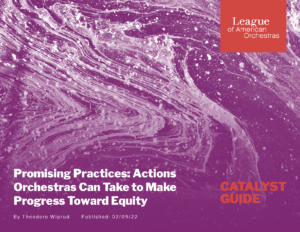 The League of American Orchestras has published a new guide, Promising Practices: Actions Orchestras Can Take to Make Progress toward Equity. The guide highlights concrete actions orchestras can take in their equity, diversity and inclusion efforts as they move toward equity within their organization, including strategic planning and audience engagement.
The League of American Orchestras has published a new guide, Promising Practices: Actions Orchestras Can Take to Make Progress toward Equity. The guide highlights concrete actions orchestras can take in their equity, diversity and inclusion efforts as they move toward equity within their organization, including strategic planning and audience engagement.
Pandemic’s Impact on Museums
More than 700 museum directors shared their pandemic experiences in a survey conducted by the American Alliance of Museums. The resulting report, National Snapshot of COVID-19 Impact on United States Museums (fielded December 2021-January 2022), includes their responses about museum closures, layoffs and financial losses; what museums are doing to cope; and new investments in nontraditional community services.
Culture as a Global Public Good
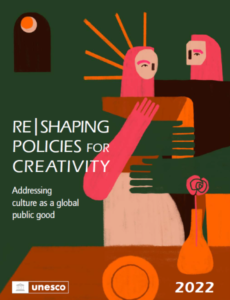 A new report published by UNESCO promotes culture’s value as a public good. Re|shaping Policies for Creativity: Addressing Culture as a Global Public Good describes how the cultural sector has suffered from the pandemic, what nations can do to recover and which cultural policies (that adhere to UNESCO’s 2005 Convention on the Protection and Promotion of the Diversity of Cultural Expressions) to promote.
A new report published by UNESCO promotes culture’s value as a public good. Re|shaping Policies for Creativity: Addressing Culture as a Global Public Good describes how the cultural sector has suffered from the pandemic, what nations can do to recover and which cultural policies (that adhere to UNESCO’s 2005 Convention on the Protection and Promotion of the Diversity of Cultural Expressions) to promote.
Representing Latinos in Museums
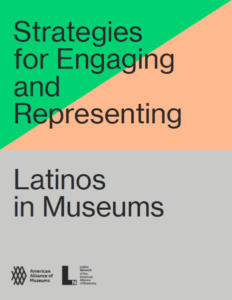 The Latino Network of the American Alliance of Museums, a professional group that advocates for better representation, has released a new guide for engagement: Strategies for Engaging and Representing Latinos in Museums. As the resource cautions, Latinos are not a monolithic group, so the strategies presented provide a starting point for understanding those who identify as Latino. The guide also offers strategies to assist museums in broadening representation across their exhibits, connecting with their local Latino communities, and growing to become more equitable and inclusive.
The Latino Network of the American Alliance of Museums, a professional group that advocates for better representation, has released a new guide for engagement: Strategies for Engaging and Representing Latinos in Museums. As the resource cautions, Latinos are not a monolithic group, so the strategies presented provide a starting point for understanding those who identify as Latino. The guide also offers strategies to assist museums in broadening representation across their exhibits, connecting with their local Latino communities, and growing to become more equitable and inclusive.
Making Arts and Culture More Accessible
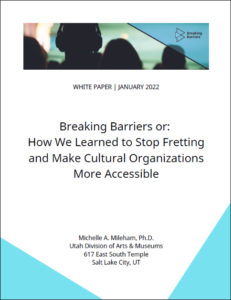 A new white paper from the Utah Division of Arts & Museums, Breaking Barriers or: How We Learned to Stop Fretting and Make Cultural Organizations More Accessible, offers a general breakdown of disability in the United States then discusses the need for greater accessibility in museums, arts and culture. An overview of Utah Division of Arts & Museums and Art Access‘s new accessibility program, Breaking Barriers: A Cultural Accessibility Project, and its impact also is presented.
A new white paper from the Utah Division of Arts & Museums, Breaking Barriers or: How We Learned to Stop Fretting and Make Cultural Organizations More Accessible, offers a general breakdown of disability in the United States then discusses the need for greater accessibility in museums, arts and culture. An overview of Utah Division of Arts & Museums and Art Access‘s new accessibility program, Breaking Barriers: A Cultural Accessibility Project, and its impact also is presented.
Update: When Will Arts Attendance Return?
SMU DataArts’s When Will Arts Attendance Return? updates previous results from two sets of analyses looking at the effect of the COVID-19 pandemic on ticket sales across 100 organizations. New results are based on data through December 31, 2021, and show that vaccinations and boosters no longer play the “savior” role that they used to; highly vaccinated counties are purchasing fewer tickets, likely due to breakthrough cases. Overall, according to the update, fluctuating COVID-19 case rates continue to exert a strong effect on ticket demand, and if case rates trend toward June 2021 levels in the first six months of 2022, predicted sales may reach 46% of their most recent four-year high by June 2022.
Arts Relevance and Engagement within Communities
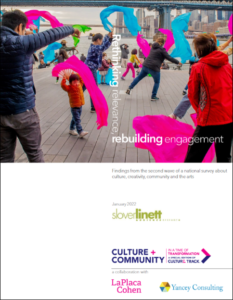 SloverLinett has just published Rethinking Relevance, Rebuilding Engagement, the cumulative findings from the second phase of Culture + Community in a Time of Transformation. The report analyzes survey data collected during the COVID-19 pandemic to better understand changing community needs, context and behaviors in relation to arts and culture organizations. Findings from the study emphasize the growing importance of arts and cultural organizations, the desire for arts organizations to be proactive in addressing social issues and systemic racism, and the evolving role of arts and culture organizations in both community involvement and digital engagement.
SloverLinett has just published Rethinking Relevance, Rebuilding Engagement, the cumulative findings from the second phase of Culture + Community in a Time of Transformation. The report analyzes survey data collected during the COVID-19 pandemic to better understand changing community needs, context and behaviors in relation to arts and culture organizations. Findings from the study emphasize the growing importance of arts and cultural organizations, the desire for arts organizations to be proactive in addressing social issues and systemic racism, and the evolving role of arts and culture organizations in both community involvement and digital engagement.
Nonprofit Demographic Trends and Impacts
The Urban Institute released national findings from a survey of nonprofit organizations that includes information about board and staff diversity, donation trends, and the pandemic related effects of 2020. The findings provide nationally representative data on the demographic characteristics of the people and communities that nonprofits serve across the United States and the demographic diversity and representation of organizations’ staff and leadership. Although findings are not specific to the arts sector, they are relevant for all state agencies that partner with or fund nonprofit organizations and can provide baseline data for nonprofit-sector diversity and representation. A fact sheet, along with the full report, provide useful facts such as: 21% of nonprofit executive directors are people of color, and 16% of nonprofits that primarily serve people of color have all-White boards.
In this Issue
From the President and CEO
State to State
- Delaware: Arts Equity and Innovation Incubator
- Oklahoma and Tennessee: Advancing Rural Arts Development
Legislative Update
The Research Digest
Announcements and Resources
More Notes from NASAA
SubscribeSubscribe
×
To receive information regarding updates to our newslettter. Please fill out the form below.
